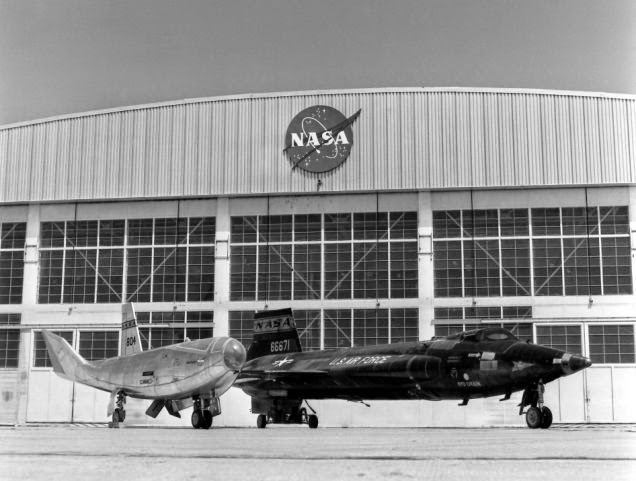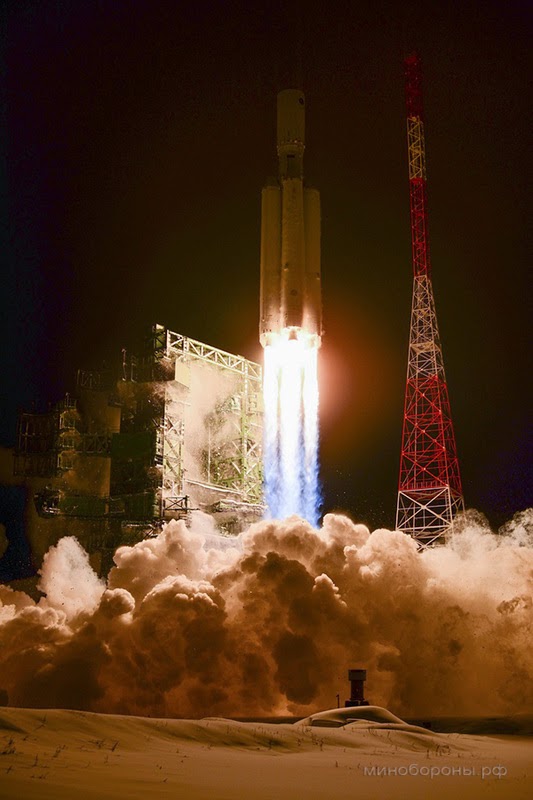Monday, December 29, 2014
Saturday, December 27, 2014
Russian Agara A5 Liftoff
Angara A5 blasts off
At Russia’s Plestek Cosmodrome, the brand new Angara A5 rocket took flight for its inaugural mission on 23 December 2014. The booster is the most powerful version of the Angara family of rockets, which are designed to ease foreign reliance on numerous aspects of the country’s current rocket fleet. Russian rockets have acquired a difficult reputation in recent years, and the Angara family is designed to change that.
Liftoff of the heavy-lift rocket occurred at the beginning of a 30-minute launch window at 12:57 PM EST, or 8:57 AM Moscow time. The rocket carried a dummy payload to Geostationary orbit for test purposes.
Official sources have released few images and details on the vehicle’s flight, however Russian news agencies are reporting that the rocket performed flawlessly.
2019
Labels:
Angara A5,
Plestek Cosmodrome,
Russian rocket
Proton M Rocket
I have mostly NASA stuff on this site, but the exploration of space extends far beyond the United States space program. Thus, let's look at a random Russian launch.
Here, a Proton-M rocket stands tall at site 200/39 at Baikonur Cosmodrome ahead of liftoff. The rocket will carry the Astra 2G satellite for SES, Luxembourg.
The Astra satellite series provides a variety of communications services to European counties. It is the third of four spacecraft in the series.
Originally scheduled for launch in November, the Proton vehicle had to return to its assembly building to replace a faulty gyroscope on the Briz-M upper stage. The rocket returned to the launch pad Christmas Eve, the same day and time a Soyuz 2-1b rocket rolled to the pad ahead of its Friday launch.
The flight profile for the satellite is shown below, provided by the launch service responsible for commercial Proton and Soyuz flights, International Launch Services.
Five engine burns of the Briz-M upper stage are required to place Astra 2G in the correct Geostationary Transfer Orbit. Nine hours and 12 minutes after launch from Baikonur, the satellite would reach its final destination 35,700 kilometers above the Equator at 28.5 degrees east longitude, just north of Madagascar.
Launch scheduled for 4:37 pm EST, or 21:37 UTC, liftoff on 27 December 2014.
Follow-up:
The Russian telecommunications satellite that was launched on Thursday disappeared from the view of ground controllers and the U.S. space surveillance network, along with the rocket upper stage that carried it into orbit, according to industry officials and the Russian space agency, Roscosmos. After the 5,800-kilogram Express-AM4 satellite separated from the Proton rocket’s Breeze-M upper stage, neither object could be found, officials said. The U.S. Space Surveillance Network of ground radars was tracking a single object that one official said was neither the Breeze-M nor the Express-AM4, but rather an auxiliary propellant tank from the Proton rocket.
But by midday ET on Friday, the U.S. Space Surveillance Network had located the Express-AM4 satellite, saying it was in an orbit with an apogee of 20,317 kilometers, a perigee of 1,007 kilometers and an inclination relative to the equator of 51.3 degrees. One industry official said it would be difficult, from this position, to maneuver Express-AM4 into operational position in geostationary orbit with sufficient life remaining to make the effort worthwhile. (via msnbc.com)
2014
Labels:
Astra 2G Satellite,
Baikonur Cosmodrome,
Proton M
Friday, December 26, 2014
X-15 Rocket Plane Program
The X-15 Program Never has been Topped
 |
| The HL-10 and X-15A2, shown here parked beside one another on the NASA ramp in 1966. |
Test pilot Joe Walker is one of the unsung heroes of aviation. He became the second man to ascend beyond 100 km when he set an altitude record of 352,200 feet for a winged vehicle on August 22, 1963. On July 19, 1963, at 18:20 UTC, as part of Test Flight 90, the X-15 helped to create the first American astronaut.
Joe Walker flew the X-15 to an apogee of more than 106km, making him the first American to exceed 100km from the surface, and only the second human to do so. He became the first human to make multiple spaceflights, again with the use of the X-15, on August 22, 1963, when he reached an apogee of more than 107km. He easily could have walked on the moon had he not perished in an unfortunate mid-air collision with a prototype XB-70 supersonic nuclear bomber.
On October 3, 1967, Major Pete Knight took the title of "the fastest man alive" when he flew an amazing 4,520 miles per hour (7,274 km/h) (Mach 6.7) in a specially modified X-15A-2. Today you can see the actual NB-52B 0008 Stratofortress that carried and released Major Pete Knight's X-15 on display by Edwards North Gate off Highway 58.
The X-15-3 (56-6672) research aircraft was maintained by ground crew at Rogers Dry Lakebed, where the landings occurred. The work of the X-15 team really began with the landing of the aircraft. Once it had stopped on the lakebed, the pilot stuck around to complete an extensive post-landing checklist. This involved recording instrument readings, pressures and temperatures, positioning switches, shutting down systems, the works. Only then was the pilot assisted from the aircraft. The small ground crew depressurized the tanks before finishing their work and carting the craft back to the hangar.
First, the specifications of the X-15:
- Length: 50 feet 9 inches (15.47 meters)
- Wingspan: 22 feet 4 inches (6.81 meters)
- Height: 13 feet 6 inches (4.11 meters)
- Empty weight: 14,600 pounds (6,622 kilograms)
- Loaded weight: 34,000 pounds (15,422 kilograms)
- Powerplant: 1× Thiokol XLR-99 liquid-fuel rocket engine developing 57,850 pounds (257.3 kilonewtons) of thrust
 |
| Do you recognize him? That's Neil Armstrong standing next to the X-15. |
 |
| This is NASA pilot Bill Dana, the last man to fly the X-15 (the 199th flight in the series) on Oct. 24, 1968. |
 |
| Note the white sealant paint. |
 |
| This is the Thiokol XLR-99 nozzle. |
2019
Tuesday, December 23, 2014
Origins of the Space Shuttle
The space shuttle was a spacecraft that was used to ferry cargo and people into low earth orbit. It was launched by a rocket and flew back into the atmosphere to a runway landing. The space shuttle flew from 1981 to 2011 for a total of 135 missions.
As with many NASA projects, the space shuttle originated from Germans who had worked in the Third Reich's rocketry program. Walter Dornberger, who had been the military liaison in Germany for Wernher von Braun and other top German scientists, submitted a proposal in 1954 for a spacecraft returning from space to a horizontal landing. This idea came under the ambit of the National Advisory Committee for Aeronautics (NACA). The scheme culminated in an aeronautics research experiment later named the X-15.
While the NACA project took time to germinate, in the late 1960s the administration of President Richard M. Nixon started looking beyond the Apollo moon program. The NACA scheme became the Integrated Launch and Re-entry Vehicle (ILRV). President Nixon authorized experiments for the ILRV based on a commission headed by Vice President Spiro T. Agnew, and by August 1973 the program was proven feasible.
2014
Labels:
ILRV,
NACA,
President Nixon,
Spiro T. Agnew,
Walter Dornberger,
X-15
Subscribe to:
Comments (Atom)












































